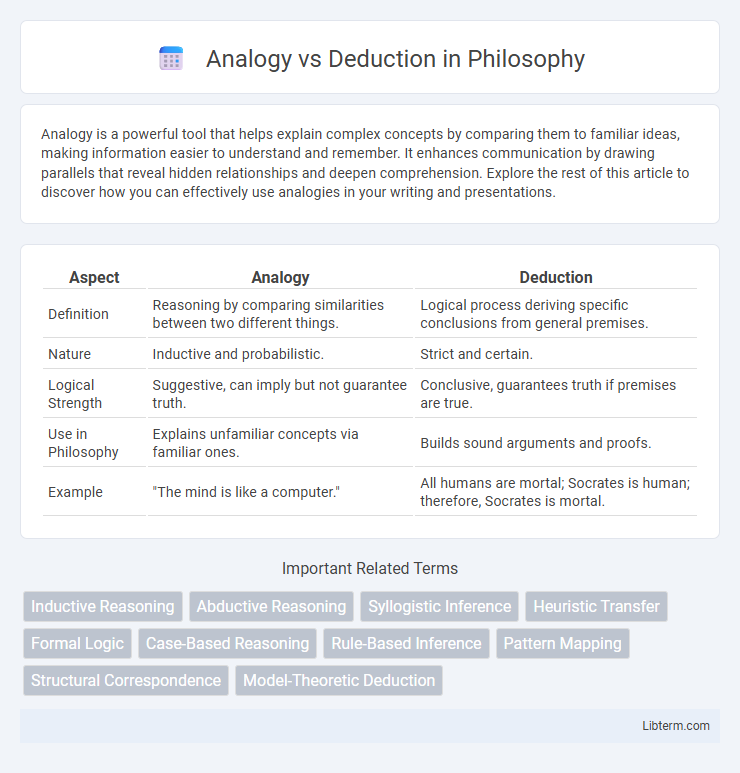Analogy is a powerful tool that helps explain complex concepts by comparing them to familiar ideas, making information easier to understand and remember. It enhances communication by drawing parallels that reveal hidden relationships and deepen comprehension. Explore the rest of this article to discover how you can effectively use analogies in your writing and presentations.
Table of Comparison
| Aspect | Analogy | Deduction |
|---|---|---|
| Definition | Reasoning by comparing similarities between two different things. | Logical process deriving specific conclusions from general premises. |
| Nature | Inductive and probabilistic. | Strict and certain. |
| Logical Strength | Suggestive, can imply but not guarantee truth. | Conclusive, guarantees truth if premises are true. |
| Use in Philosophy | Explains unfamiliar concepts via familiar ones. | Builds sound arguments and proofs. |
| Example | "The mind is like a computer." | All humans are mortal; Socrates is human; therefore, Socrates is mortal. |
Understanding Analogy: Definition and Purpose
Analogy involves identifying similarities between two different concepts or situations to infer conclusions or explain ideas, serving as a cognitive tool for problem-solving and learning. It helps in transferring knowledge from a familiar context to an unfamiliar one, enhancing comprehension and reasoning. Understanding analogy requires recognizing relational patterns rather than relying solely on exact matches or logical certainty as in deduction.
Deductive Reasoning: Core Principles
Deductive reasoning operates on the principle that if the premises are true, the conclusion must be true, ensuring logical certainty and validity. It begins with general statements or laws and applies them to specific cases to derive conclusions, exemplified by syllogisms or mathematical proofs. This form of reasoning is foundational in scientific methods and formal logic for constructing irrefutable arguments based on established facts.
Key Differences Between Analogy and Deduction
Analogy involves drawing conclusions based on similarities between two different entities, relying on parallel relationships to infer new information, while deduction applies general principles or premises to reach a logically certain conclusion. Analogy often supports probabilistic reasoning and creative problem-solving, whereas deduction guarantees truth if the premises are true. Key differences include analogy's reliance on empirical observation and likeness, contrasted with deduction's foundation in formal logic and necessity.
Examples of Analogical Reasoning
Analogy involves drawing parallels between two different domains to infer conclusions, such as comparing the structure of an atom to a solar system to explain electron orbits. Deduction, however, starts with general premises to arrive at specific conclusions, like asserting that all mammals have lungs and therefore whales, as mammals, have lungs. Examples of analogical reasoning frequently appear in legal arguments, where past case outcomes are used to infer rulings in new, similar cases.
Examples of Deductive Reasoning
Deductive reasoning involves drawing specific conclusions from general principles, such as in the classic syllogism: "All humans are mortal; Socrates is a human; therefore, Socrates is mortal." Another example is mathematical proofs, where statements like "If all angles in a triangle add up to 180 degrees, and this shape is a triangle, then its angles sum to 180 degrees" demonstrate deduction. Logic puzzles also use deduction by applying established rules to arrive at a certain outcome based on given premises.
Advantages of Analogy in Problem Solving
Analogy enhances problem solving by enabling the transfer of knowledge from familiar situations to unfamiliar ones, facilitating creative and flexible thinking. It allows for the identification of patterns and relationships, which can simplify complex problems and generate innovative solutions. This method also supports learning and adaptation by leveraging previous experiences to tackle novel challenges effectively.
Strengths of Deductive Reasoning
Deductive reasoning offers unparalleled logical certainty by deriving specific conclusions from general premises, ensuring validity if the initial statements are true. This method provides clarity and precision, making it highly effective for formal proofs and mathematical problem-solving. Its strength lies in producing conclusions that are definitively true within the framework of the given information, minimizing ambiguity and enhancing decision-making accuracy.
Limitations of Analogy vs Deduction
Analogy often struggles with limitations due to its reliance on similarity between cases, which can lead to inaccurate conclusions if the compared instances differ in crucial aspects. Deduction provides more reliable certainty by deriving conclusions logically from premises, but it is constrained by the truth and completeness of those initial premises. While deduction ensures validity within its framework, analogy may produce insights with less rigor, making it less dependable for formal reasoning or critical decision-making.
When to Use Analogy or Deduction
Analogy is best used when reasoning about unfamiliar situations by comparing them to known cases, especially when direct evidence is limited or incomplete, allowing inference based on similarity. Deduction is most effective when premises are clear, well-defined, and logically sound, enabling conclusions that are necessarily true if the premises are true. Use analogy for exploratory thinking and hypothesis generation, while deduction suits formal proofs and situations requiring guaranteed validity.
Integrating Analogy and Deduction for Better Outcomes
Integrating analogy and deduction leverages the strengths of both reasoning methods to enhance problem-solving effectiveness. Analogy facilitates creative insights by drawing parallels between similar situations, while deduction ensures logical rigor through systematic application of established principles. Combining these approaches enables more comprehensive analysis, improved decision-making, and robust solutions in complex scenarios.
Analogy Infographic

 libterm.com
libterm.com